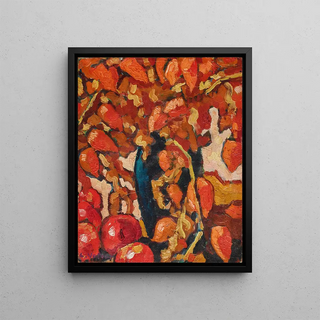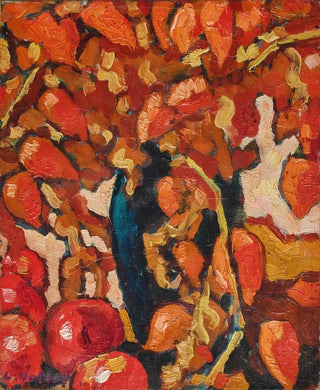Art print | Physalis and apples - Louis Valtat


View from behind

Frame (optional)
In the fascinating world of art, some works manage to capture the very essence of nature while revealing the unique sensitivity of their creator. "Physalis and Apples - Louis Valtat" is one of those creations that, through its dazzling beauty and thoughtful composition, invites the viewer to a deep contemplation. This painting, both simple and complex, evokes a silent dialogue between the depicted objects and the space surrounding them. The vibrant colors and delicate shapes seem to dance on the canvas, attracting the eye and awakening the senses. Approaching this piece, one feels an immediate connection with the natural world, as if the fruits and flowers come to life before our eyes.
Style and uniqueness of the work
Louis Valtat's style is distinguished by his bold approach to post-impressionism, blending a palette of luminous colors with stylized forms. In "Physalis and Apples," this artistic signature manifests through a subtle play of light and shadow, where each element is carefully arranged to create visual harmony. The physalis, with their translucent husk, evoke an almost ethereal delicacy, while the apples, symbols of fertility and abundance, add a touch of warmth and familiarity. The work is characterized by a perfect balance between abstraction and realism, where blurred contours and expressive brushstrokes inject a lively dynamism into the composition. This painting, while a still life, transcends its genre through the emotional power it exudes.
The artist and his influence
Louis Valtat, an emblematic figure of the post-impressionist movement, knew how to mark his era with an innovative artistic vision. Influenced by the masters of impressionist painting, he developed a style that is uniquely his own, combining the rigor of drawing with unprecedented freedom of expression. His work, rich in colors and textures, demonstrates a deep understanding of light and its effects on objects. Valtat was also a pioneer in the use of color, experimenting with bold palettes that inspired many contemporary artists. Through his work, he opened the

Matte finish

View from behind

Frame (optional)
In the fascinating world of art, some works manage to capture the very essence of nature while revealing the unique sensitivity of their creator. "Physalis and Apples - Louis Valtat" is one of those creations that, through its dazzling beauty and thoughtful composition, invites the viewer to a deep contemplation. This painting, both simple and complex, evokes a silent dialogue between the depicted objects and the space surrounding them. The vibrant colors and delicate shapes seem to dance on the canvas, attracting the eye and awakening the senses. Approaching this piece, one feels an immediate connection with the natural world, as if the fruits and flowers come to life before our eyes.
Style and uniqueness of the work
Louis Valtat's style is distinguished by his bold approach to post-impressionism, blending a palette of luminous colors with stylized forms. In "Physalis and Apples," this artistic signature manifests through a subtle play of light and shadow, where each element is carefully arranged to create visual harmony. The physalis, with their translucent husk, evoke an almost ethereal delicacy, while the apples, symbols of fertility and abundance, add a touch of warmth and familiarity. The work is characterized by a perfect balance between abstraction and realism, where blurred contours and expressive brushstrokes inject a lively dynamism into the composition. This painting, while a still life, transcends its genre through the emotional power it exudes.
The artist and his influence
Louis Valtat, an emblematic figure of the post-impressionist movement, knew how to mark his era with an innovative artistic vision. Influenced by the masters of impressionist painting, he developed a style that is uniquely his own, combining the rigor of drawing with unprecedented freedom of expression. His work, rich in colors and textures, demonstrates a deep understanding of light and its effects on objects. Valtat was also a pioneer in the use of color, experimenting with bold palettes that inspired many contemporary artists. Through his work, he opened the






